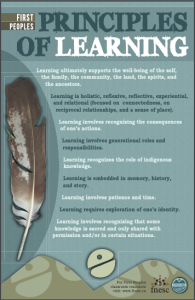Multimedia and Multiplace Based Learning
Language and culture are integrated into every subject and discipline in my school community. Students are learning the language of SENĆOŦEN, which is spoken in their surrounding communities and at home. Most are fluent, some are enrolled in the immersion program, and many only speak this language at home. The process of learning SENĆOŦEN does not happen from simply writing the words on paper; it is critical to hear, feel, and see the words in context. For example, when learning about plants and plant names, we go out onto the land and find the plant in its natural habitat. The SENĆOŦEN name for Tod Inlet is SṈITȻEȽ – which means the land of the blue grouse. To learn the name for Tod Inlet, and for its meaning to be significant, visiting the land and observing the species which interact and exist at the site creates a deeper connection and understanding to the name. If students were to only learn the name for Tod Inlet on paper in the classroom, it would merely be a name on a list that they would have to memorize later. SENĆOŦEN and the process of learning languages is a perfect example of multimedia/modal learning to effectively understand content. You cannot integrate a language into your everyday life without hearing it, writing it, and experiencing the roots of the words themselves. The Basic Principals of Multimedia Learning was significant to me and I have been able to observe this teaching practice through a First Nations lens, which also integrates the First Peoples Principals of Learning.
Games and Their Purpose
Game-based learning is integrated heavily into our remote Introduction to Computer Science course. Students are designing projects using Avatars and recreating retro games such as Snake and Pong. Designing, experimenting, creativity, and a sense of play are principals in which this course focuses around. Lots of time is given to students to explore our coding programs, play the games, and create projects which represent their interpretation of the project outline. An example is students are encouraged to play games like Roblox, Lightbot, or Minecraft on lab days to be inspired by how those games run and are designed for their own projects. SNAP! is the workspace from which students create, which in itself is a digital Makerspace. Without an objective or guidance from the instructors when students are in SNAP!, this platform wouldn’t be effective. A frontloading of information and scaffolding is necessary to show students how to create code to move their characters, build game platforms, and perform actions. This was a large topic examined in the Game-based learning article: a Makerspace is a platform for learning but it won’t provide the learning itself. What Makerspaces, such as SNAP!, allow for is scaffolded instructions to equip students with the skills to produce projects inspired by their individual creativity.
Leadership and Connection

First Peoples Principles of Learning. http://www.fnesc.ca/wp/wp-content/uploads/2015/09/PUB-LFP-POSTER-Principles-of-Learning-First-Peoples-poster-11×17.pdf
Our proposed project will emphasize the disconnect and hesitation new teachers in terms of integrating First Nations content into their practice, whether they themselves are First Nations or not. Teaching can be an isolating field, with many resources only being pulled from the internet or ancient books found amongst bookshelves at the back of the library. Since I started at the First Nations Leardership school, it became apparent how important collaboration and the sharing of knowledge is to really understand how to incorporate these Ways of Knowing and Principals of Learning into your lessons and pedagogy.
The Role of Leadership for Information Technology aligned with these Principles in a refreshing way, as it outlined how to integrate traditional, spoken knowledge and information sharing, with digital platforms and resources. A main idea behind these Leadership principles was adaptation and collaboration. In order for the information that is being shared to be useful, it must be presented in a way which is appropriate for the audience and situation where the learning is occurring. This is a shift in approach, where teachers must now consider is the resource they are using appropriate for who and where they are teaching. A collaboration between the knowledge keepers in the community or school district to look at the resource would clarify and improve the way our resources are being used. An example of this blending of traditional knowledge and digital media that is used frequently in my practice, and will be a feature in our project, is the SENĆOŦEN first voices website. Elders and speakers from the community have contributed their words to construct a comprehensive and interactive website containing words, stories, and media to teach the understandings of groups using that language. This website could be viewed from the five guiding principals for integrating technology in schools. The main principles that it follows are one of positivity, constructiveness, and simultaneity. It is a resource which acknowledges that the preservation of language requires perseverance and resiliency; the contributors are motivated by the possibilities and future where the next generation still can speak and use their language; and the elders and knowledge keepers are active in the schools and communities, answering questions about their culture and language to keep the fire and language alive for generations.
Leave a Reply